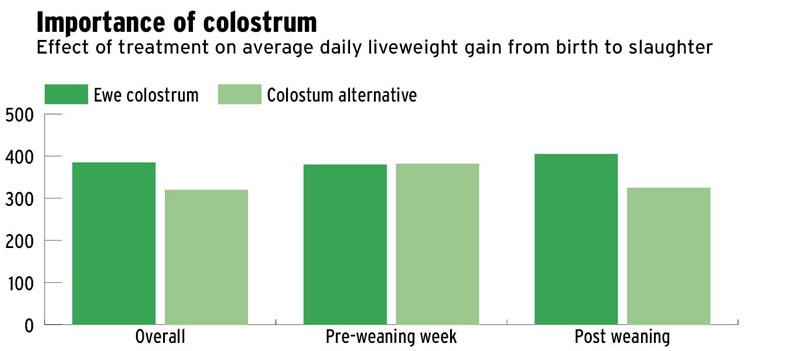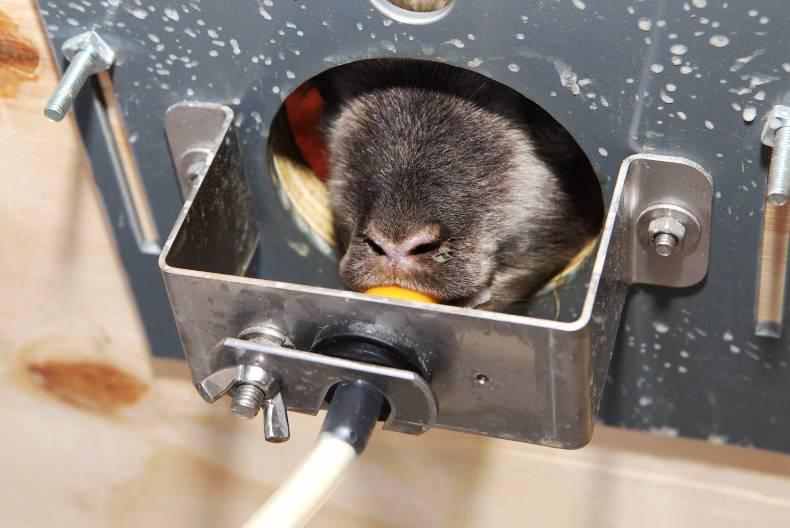Many aspects of a recent ASA sheep technology training day held in UCD Lyons Research Farm were covered in the sheep pages at the end of January. The topic of artificially rearing lambs was also addressed by Tommy Boland, senior lecturer in ruminant nutrition and sheep production at UCD.
One aspect of the trial carried out on artificial rearing of lambs looked at the performance of lambs offered ewe colostrum or a colostrum alternative. The study showed that lambs offered ewe colostrum had a significantly higher level of gain post-weaning than those that received the colostrum alternative/supplement. This is despite lambs being managed in exactly the same way.
Lamb management
Tommy explains the trial was carried out to investigate alternative ways of rearing triplet-born lambs with a preference in the flock of cross-fostering or artificially rearing triplet-born lambs over letting a ewe outdoors suckling three lambs. For the purpose of the trial and experimental reasons, one lamb from each set of triplets was removed at birth. Lambs were stomach-tubed with either ewe colostrum or the colostrum alternative at one, 10 and 18 hours after birth and then trained to drink with ad-lib access to milk replacer from 24 hours of age.
Concentrate supplementation was introduced and offered ad lib from seven days of age. Intake was closely monitored and lambs were weaned off milk replacer once they were consuming 250g concentrate daily. This occurred at an average of about six weeks of age and is regarded as a key performance indicator as if lambs are not eating this level their rumen won’t be sufficiently developed to perform on a solid feed diet after weaning. There was no difference in performance pre-weaning between the two treatments, with both groups recording excellent performance of about 380g per day.
Post-weaning, lambs were housed indoors and offered a commercial concentrate ad lib. Body weight was assessed weekly and lambs were slaughtered once they reached 44kg liveweight. The lambs that received ewe colostrum left their counterparts behind post-weaning and reached slaughter at an average age of 109 days versus 133 days for lambs receiving the colostrum alternative. There was no significant difference in carcase traits.
Lambs receiving ewe colostrum achieved excellent lifetime performance averaging in the region of 390g daily. Tommy says that this shows there is potential to push performance of suckling lambs with adequate nutrition of ewes to maximise milk yield and access for lambs to top-quality forage. Lifetime performance of the group receiving the colostrum alternative was still positive at an average of 325g, but given that these lambs took 24 days longer to reach slaughter on an ad-lib diet, the economics of finishing lambs can be greatly increased by offering ewe colostrum where possible.

This is not to say that colostrum supplements or alternatives are inadequate. They can be a very useful aid where ewe colostrum is in short supply, providing lambs with a source of energy which is vital for heat production and keeping lambs alive in the first few hours of life.
Tommy points out a good balance can be achieved by ensuring lambs receive some ewe colostrum if possible to promote antibody intake, with any deficit in volume made up with a top-up from a colostrum supplement. Milking colostrum from ewes with excess milk will help achieve this goal, with colostrum frozen once cooled and slowly defrosted when required.
One reason highlighted for the lower performance in the UCD trial was a higher incidence of disease in lambs receiving the colostrum alternative. A recent trial in the University of Cambridge found that the level of immunoglobulin (IgG) found in a recommended feeding rate of colostrum alternatives on the market was only a fraction of what a ewe provides, strengthening the case for farmers to use colostrum alternatives as a supplement.
Accelerated growth of lambs
The trial shows the importance of ewe colostrum but it also details an option for rearing triplet or orphan lambs. Performance varies between animals, with intakes increasing rapidly as animals get older. Previous results show intakes ranging from 250g milk replacer in week one to 550g in the final week pre-weaning.
Triplet-born lambs finished in this manner in 2014 consumed an average of 84kg concentrates, reaching slaughter at an average age of 123 days with a live weight of 43kg and kill-out of 47% on average delivering a carcase weight of 20.2kg. Care must also be taken to ensure lambs meet market requirements and in particular do not go over-fat.
Tommy details a number of tips, as follows, if progressing down a similar route:
Many aspects of a recent ASA sheep technology training day held in UCD Lyons Research Farm were covered in the sheep pages at the end of January. The topic of artificially rearing lambs was also addressed by Tommy Boland, senior lecturer in ruminant nutrition and sheep production at UCD.
One aspect of the trial carried out on artificial rearing of lambs looked at the performance of lambs offered ewe colostrum or a colostrum alternative. The study showed that lambs offered ewe colostrum had a significantly higher level of gain post-weaning than those that received the colostrum alternative/supplement. This is despite lambs being managed in exactly the same way.
Lamb management
Tommy explains the trial was carried out to investigate alternative ways of rearing triplet-born lambs with a preference in the flock of cross-fostering or artificially rearing triplet-born lambs over letting a ewe outdoors suckling three lambs. For the purpose of the trial and experimental reasons, one lamb from each set of triplets was removed at birth. Lambs were stomach-tubed with either ewe colostrum or the colostrum alternative at one, 10 and 18 hours after birth and then trained to drink with ad-lib access to milk replacer from 24 hours of age.
Concentrate supplementation was introduced and offered ad lib from seven days of age. Intake was closely monitored and lambs were weaned off milk replacer once they were consuming 250g concentrate daily. This occurred at an average of about six weeks of age and is regarded as a key performance indicator as if lambs are not eating this level their rumen won’t be sufficiently developed to perform on a solid feed diet after weaning. There was no difference in performance pre-weaning between the two treatments, with both groups recording excellent performance of about 380g per day.
Post-weaning, lambs were housed indoors and offered a commercial concentrate ad lib. Body weight was assessed weekly and lambs were slaughtered once they reached 44kg liveweight. The lambs that received ewe colostrum left their counterparts behind post-weaning and reached slaughter at an average age of 109 days versus 133 days for lambs receiving the colostrum alternative. There was no significant difference in carcase traits.
Lambs receiving ewe colostrum achieved excellent lifetime performance averaging in the region of 390g daily. Tommy says that this shows there is potential to push performance of suckling lambs with adequate nutrition of ewes to maximise milk yield and access for lambs to top-quality forage. Lifetime performance of the group receiving the colostrum alternative was still positive at an average of 325g, but given that these lambs took 24 days longer to reach slaughter on an ad-lib diet, the economics of finishing lambs can be greatly increased by offering ewe colostrum where possible.

This is not to say that colostrum supplements or alternatives are inadequate. They can be a very useful aid where ewe colostrum is in short supply, providing lambs with a source of energy which is vital for heat production and keeping lambs alive in the first few hours of life.
Tommy points out a good balance can be achieved by ensuring lambs receive some ewe colostrum if possible to promote antibody intake, with any deficit in volume made up with a top-up from a colostrum supplement. Milking colostrum from ewes with excess milk will help achieve this goal, with colostrum frozen once cooled and slowly defrosted when required.
One reason highlighted for the lower performance in the UCD trial was a higher incidence of disease in lambs receiving the colostrum alternative. A recent trial in the University of Cambridge found that the level of immunoglobulin (IgG) found in a recommended feeding rate of colostrum alternatives on the market was only a fraction of what a ewe provides, strengthening the case for farmers to use colostrum alternatives as a supplement.
Accelerated growth of lambs
The trial shows the importance of ewe colostrum but it also details an option for rearing triplet or orphan lambs. Performance varies between animals, with intakes increasing rapidly as animals get older. Previous results show intakes ranging from 250g milk replacer in week one to 550g in the final week pre-weaning.
Triplet-born lambs finished in this manner in 2014 consumed an average of 84kg concentrates, reaching slaughter at an average age of 123 days with a live weight of 43kg and kill-out of 47% on average delivering a carcase weight of 20.2kg. Care must also be taken to ensure lambs meet market requirements and in particular do not go over-fat.
Tommy details a number of tips, as follows, if progressing down a similar route:
Ensure ewes are fed adequately in late pregnancy. This will result in lambs with a good birthweight and vigour and ewes with sufficient colostrum.Leave lambs suckling with ewes for 24 to 36 hours. This is the best option provided ewes have sufficient colostrum.Selecting a large male lamb will optimise growth rates on an intensive diet and reduce age to slaughter.Monitor lambs when introduced to the feeder as some lambs are slower to take to it and may need extra attention to ensure sufficient intake is achieved.An infrared lamp can be used to provide artificial heat for the first few days of life which will help lambs get off to a good start.Group lambs of a similar age and size and target group size to the feeder’s capabilities.Keep equipment clean and milk replacer fresh. Monitor for teat damage. Lambs will chew teats regardless but will chew more if milk is allowed to run out.Provide access to fresh concentrates at a young age. Intakes will be small initially but if not introduced early will not reach 250g daily until later than six or seven weeks.Salt was added at 1% to the ration to promote water intake, while ammonium chloride was added at 0.5% to reduce the risk of urinary calculi.Monitor live weight and fat cover regularly as lambs approach slaughter. 






 This is a subscriber-only article
This is a subscriber-only article









SHARING OPTIONS: